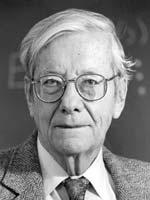Nicolaas Bloembergen
About Optica
In Memoriam: Nicolaas Bloembergen, 1920-2017
05 September 2017

Nicolaas “Nico” Bloembergen, Nobel Laureate and OSA Honorary Member, passed away on 5 September 2017 at the age of 97. Bloembergen was known for his pioneering work in developing driving principles behind nonlinear optics for laser spectroscopy. Bloembergen shared the 1981 Nobel Prize in Physics with Arthur Schawlow and Kai Siegbahn. The Nobel Foundation awarded Bloembergen and Schawlow the Prize for their contribution to the development of laser spectroscopy.
Bloembergen was born in Dordrecht, Netherlands, and studied physics at the University of Utrecht. During World War II, the University was closed and Bloembergen moved to Harvard University, where he studied under Professor Edward Mills Purcell. Bloembergen was hired to develop the first nuclear magnetic resonance (NMR) machine. Bloembergen's NMR systems are still in use currently in medicine, where it is used to examine internal organs and tissues. Bloembergen’s research on NMR led to an interest in masers, which were introduced in 1953.
Bloembergen returned to the Netherlands in 1947 and received his Ph.D. degree from Leiden in 1948. He became an Associate Professor at Harvard in 1951 and held numerous positions during his tenure, prior to his retirement in 1990. In addition to his placement at Harvard, Bloembergen served as a visiting professor at the University of California Berkeley and University of Arizona. In 1956, Bloembergen developed a crystal maser, which was more powerful than the standard gaseous version and participated in the development the field of laser spectroscopy, which allows precise observations of atomic structure using lasers.
Bloembergen married Huberta Deliana Brink (Deli) in 1950 and they were both naturalized as US citizens in 1958. They had three children and resided in Tucson, Arizona during their retirement.
OSA and the scientific community mourns the loss of Nico Bloembergen.
